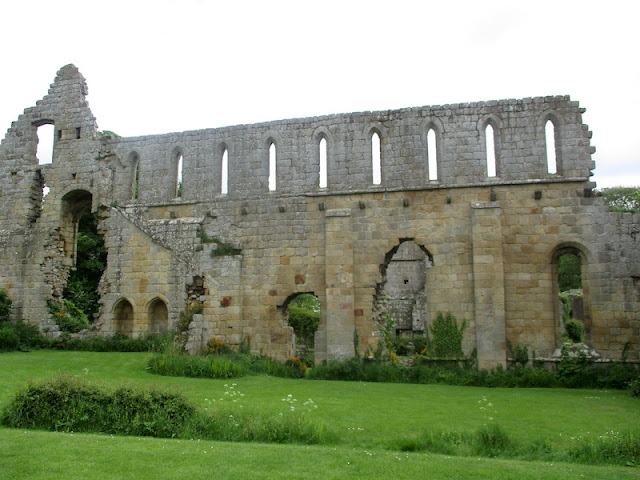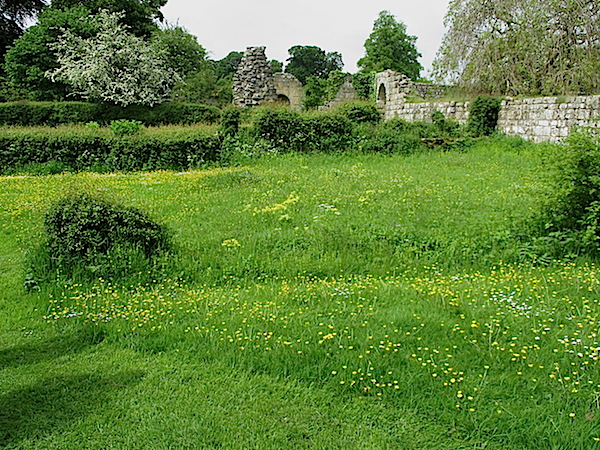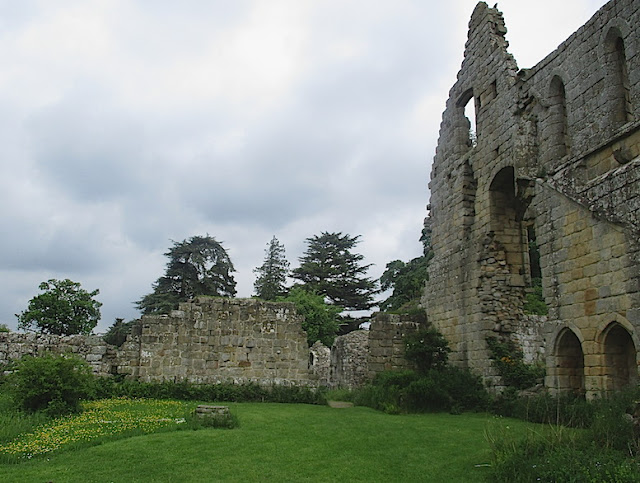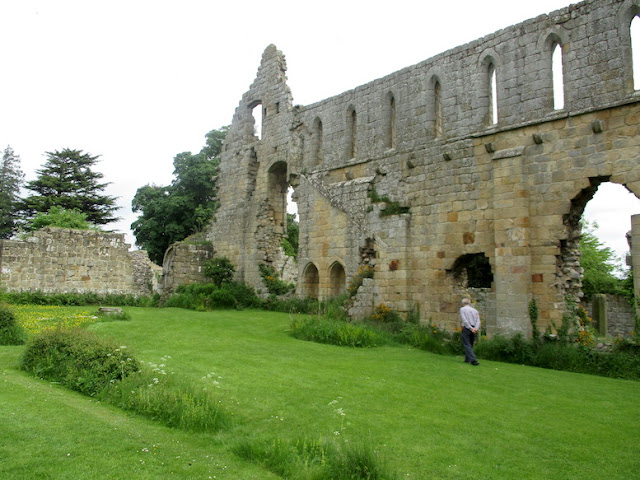 |
| Jervaulx Abbey in June |
We were on our way to Aysgarth. Our mission was to take pictures of the rock garden there, that magnificent crazy pile of stones. We drove through soft picturesque sylvanYorkshire Dales countryside. I cannot find words to describe its beauty in late May. We had been told that on the way there were some very good tearooms and stopped for morning coffee.
Apparently across the road there were the remains of an old Cistercian Abbey. Those ancient stones were to make our day.
Peter and I regarded it a small penance to be dragged round old ruins by Brenda and Julie. In the event when we saw that they were clothed with wild flowers you could not drag us away.
Jervaulx Abbey is privately owned by the Burdon family. It is magnificently managed and stands proud in accessible sheep grazed fields and light rural woodland. There is no intrusive visitor centre typical of other places. Since 1982 it has been honesty box payment. With enthusiasm we paid our three pound donation on exit.
In point of fact the aforementioned tea rooms is also a visitor centre and un-intrusively provides all you need to know. Julie had bought their guide. To those interested in real history it is very informative. Of the fantastic wild flowers not a mention.
Most old abbeys are normally maintained free of vegetation. At Jervaulx their policy is different and they take the view that clothing ruins with vegetation might help to preserve them. It certainly enhances their beauty.
The management of vegetation must of course be very sensitive. Rampant brambles, nettles and oversized seedling trees would cause severe damage especially if mechanically dragged away. All are actually present but in the refined company of more select wild flowers. There is sensitive and highly skilled management and selective removal by pruning and dare I speculate, spot treatment with herbicides. I don’t know for certain, but Peter and I think we spotted a nettle chemically withered!
There are many fine old monuments, old churches and abbeys where an historical record and native flowers have been destroyed by removing natural vegetation in a tidy system of management. Not here now.
At Jervaulx the mixture of shrubs, trees, wild flowers and garden escapes on the stones are actually quite ordinary. Only a few are rare and the ferns in the cracks of the stone are quite special. The real genius is in how they combine. Nature has put them there but man has maintained the illusion of wildness.
Whoever maintains the vegetation at Jervaulx is a genius! There is no mention of he or she in the literature but from month to month and year upon year their is a delicate touch on the tiller.
It would be nice if in due course any reader who really knows the secret of Jervaulx will enlighten us.
I try to tell our story in pictures today
Picture post; the wild flowers of Jervaulx
 |
| From matins to vespers he attends ten services each day |
 |
| Dressed with green vegetation the rooms and cloisters of Jervaulx are a joy. The guide book details how the monks lived their lives |
 |
| Every corner turned brings a new delight |
 |
| Toad flax, ivy and geranium are charming |
 |
| I can spot nettles, brambles and hazel. Can anyone identify the fern? |
 |
| What can you spot here in the glorious jumble? I will give you a start, aubretia, forget-me-not and hedge garlic |
 |
| Differential mowing showcases the buttercups and cowslips |
 |
| Peter and I had been discussing thrum and pin eyed flowers |
 |
| One of our nicest native flowers |
 |
| How could anyone pull out lovely speedwell? |
 |
| It looks a little precarious! |
 |
| I wonder what is down there |
 |
| Wallflowers are best in walls |
 |
A special kind of beauty. So much better than just stones. By the end of the season it will be time to prune these saplings away. New seedlings will provide continuity
 |
| There are dozens of rooms |
|
 |
| Is the ivy holding things together? |
 |
| What lovely stone. The yew seedling can stay for a while |
 |
| In high rainfall areas ferns thrive in walls |
 |
| As kids we called them chimney sweep brushes. I wonder if they descend from the monk’s herbs? |
 |
| I love moss on stone |
 |
| Now at its best in the last days of May. At this time the only maintenance needed is mowing the lawn |
 |
| In the fifteen hundreds the grounds would be a small artisan town |
 |
| Entrance and exit. As you leave you see the gruesome embalming stone (off picture) |
Links
A book about wild flowers on roadsides
Richard Mabey’s observation about destruction of the archive of 2000 years vegetation when the colosseum was ‘restored’

























In April I wrote a post about pin and thrum eyed primulas.
ReplyDeleteWe were at Fountains Abbey recently and although there wasn't as much vegetation there were wild plants growing from the walls and the jackdaws were making good use of potential nesting places. I'm not sure what they made of the wayward eagle from a nearly bird of prey centre recently spending a night amongst them.
Readers should go to Sue's website to swot up on pin and thrum. They will need to to understand my currently garbled post in the making!
DeleteWow an eagle at Fountains!
That's abbey one-upmanship!
Is a nearly bird a kind of early bird?
No it should be nearby. You make me so nervous that I keep making these mistakes.
DeleteYes I know what you meant. You nervous?
DeleteFascinating stuff Roger, wild flowers are probably not mentioned because they are taken for granted! The jumble reminds me of my garden, as for the fern I am sure I have one but no idea what it is. I also didn't know you could wax so poetical.....sylvan!!
ReplyDeleteYes I have the fern as well but have also forgot its name. Hope someone will help, its not rare but is a lovely fern. Next time I go to Reighton near Filey where I bought it I will check it out
DeleteHope I have got the meaning right of sylvan!
Is it a shuttlecock fern?
ReplyDeleteI don't think so, Sue. It does not look quite like the one outside my window which looks a tighter shuttle.
DeleteIt does look very similar however, I will leave your suggestion on the table. Thank you for putting your head over the parapet
Wild Flowers of New York are of great species and with a large variety. It certainly interests any kind of flower lover. Wild flowers are beautiful, fragrant and colorful. Wild flowers also can be grown in gardens as well. These flowers have mixed hybrid varieties that are grown in different colors and characteristics.
ReplyDeleteEnjoyable post. Regarding fern: newly unfurled fronds of the male fern, Dropteris filix-mas?
ReplyDeleteThanks for this Tom, dryopteris was on my short list but I did not want to publish my 'guess'. I am seeing Pete tonight - he might confirm. In due course I will enter the name on the post - I must look at some pictures on google images - although their plant identification means very little!
DeleteI much appreciate your information
You're quite welcome Roger, of course. I was able to have a reasonable stab at the name as I live adjacent to a wood on the North York moors where Male ferns pop up all over the place, wonderful stately plants they are too.
ReplyDelete